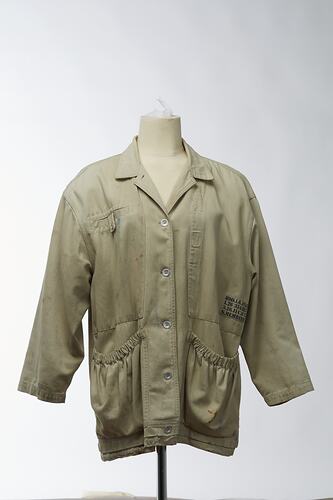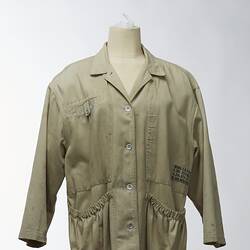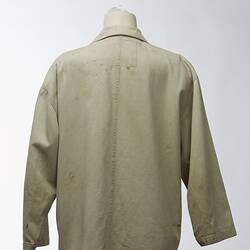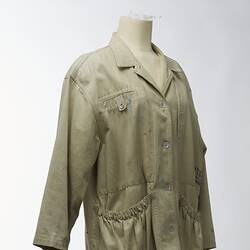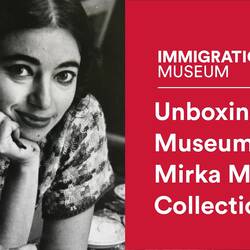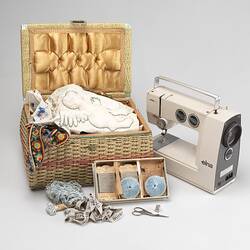Summary
Painting coat adapted from a Stuart Membery designed jacket. It was owned and used by Mirka in her art studio in Tanner Street Richmond from the year 2000 when Mirka located there after having lived in an number of residences and studios in Melbourne CBD, Toorak, and St Kilda.
According to Stuart Membery, the jacket was designed as part of his 1984 WINNING Collection, which came about after Australian singer Olivia Newton John asked him to design an outfit for the Opening Ceremony of the1984 Summer Olympics in Los Angeles. He then created a whole collection in sepia tones inspired by the 1924 Paris Olympics, as depicted in the 1981 film Chariots of Fire. The collection was very well received, and was showcased across the USA.
This is one of a collection of artist's materials, sewing equipment, clothing and personal items relating to the life and work of iconic Melbourne artist Mirka Mora, sourced from her Richmond artist studio in 2019. Membery noted that the sleeves have been shortened by Mirka, probably to protect them from paint stains while she worked.
Physical Description
Beige canvas coat with large elasticised pockets, silver coloured buttons and a single button down breast pocket. Coat has paint splatters on it, and a Stuart Membery garment tag and patch sewn on.
Significance
Statement of Historical Significance:
There are few names as synonymous with Melbourne's cultural and artistic life as Mirka Mora. Artist and café and restaurant owner, her larger than life personality and her very accessible and public art dominated Melbourne's cultural landscape for over 50 years. Mirka was a post World War II migrant and a leader in the formative years of Melbourne artistic and cultural urban development. Mirka embodied the spirit of bohemian Melbourne for decades and this diverse collection provides an entry point to appreciating the rich life of a complex, multi-faceted woman. The material represents a migrant, cultural and artistic life, revealing her artistic processes, influences and style,and brings the personal side of Mirka to life.
This collection also complements one of the migration collection's strongest sub-collections, the Immigration and Artistic Practice collection. This collection draws on artworks, materials, equipment, migration objects and oral histories to explore how Victorian migrant artist's adapt, develop and transform their artistic practice within a new social, cultural and artistic environment. It provides evidence of the richness provided to the documenting of migrant artist's lives, not just through their artworks, but through the materials showing how their practice evolved over time.
More Information
-
Collecting Areas
Migration & Cultural Diversity, Working Life & Trades, Clothing & Textiles
-
Original Owner
-
Designer
Mr Stuart Membery, Sydney, Greater Sydney, New South Wales, Australia, 1984
-
Classification
Migration, Settlement - cultural & social life, Tools & equipment
-
Category
-
Discipline
-
Type of item
-
Overall Dimensions
600 mm (Width), 777 mm (Height)
Measured flat.
-
Keywords
Artists, Art, Painting Equipment, Australian Fashion Industry, Clothing, Coats
